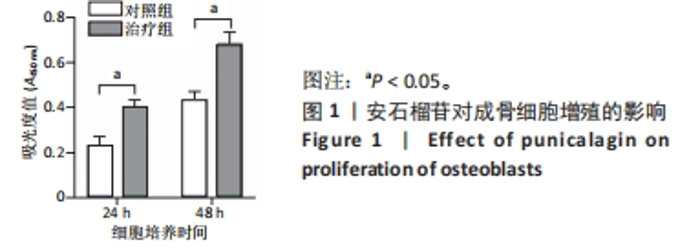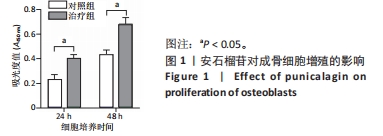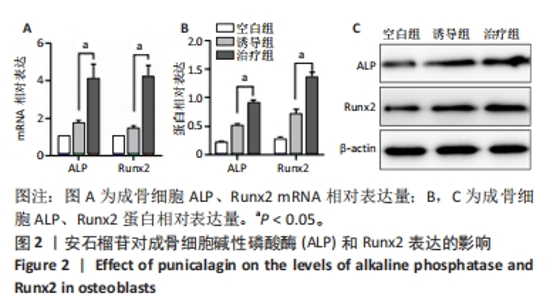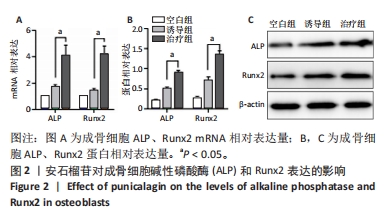Chinese Journal of Tissue Engineering Research ›› 2024, Vol. 28 ›› Issue (26): 4101-4105.doi: 10.12307/2024.438
Punicalagin treats postmenopausal osteoporosis by promoting osteogenesis
Zhang Shudong1, Huang Yilin1, Yao Qi2
- 1Second Department of Orthopedics, The First Affiliated Hospital of Henan University, Kaifeng 475000, Henan Province, China; 2Department of Joint, Beijing Shijitan Hospital, Capital Medical University, Beijing 100038, China
-
Received:2023-07-12Accepted:2023-08-09Online:2024-09-18Published:2023-09-28 -
Contact:Yao Qi, MD, Chief physician, Master’s supervisor, Department of Joint, Beijing Shijitan Hospital, Capital Medical University, Beijing 100038, China -
About author:Zhang Shudong, Master, physician, Second Department of Orthopedics, The First Affiliated Hospital of Henan University, Kaifeng 475000, Henan Province, China -
Supported by:Medical Education Research Project of Henan Province, No. Wjlx2021388 (to HYL)
CLC Number:
Cite this article
Zhang Shudong, Huang Yilin, Yao Qi. Punicalagin treats postmenopausal osteoporosis by promoting osteogenesis[J]. Chinese Journal of Tissue Engineering Research, 2024, 28(26): 4101-4105.
share this article
Add to citation manager EndNote|Reference Manager|ProCite|BibTeX|RefWorks
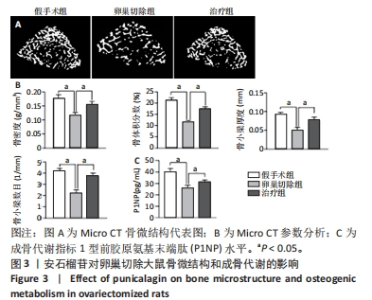
2.3 安石榴苷对绝经后骨质疏松症大鼠的治疗作用 由图3A可知,卵巢切除组骨小梁较假手术组稀疏,结构紊乱,治疗组骨小梁数量有所增加,但仍较假手术组少。由图3B可知,卵巢切除组骨密度较假手术组显著降低,差异有显著性意义(P < 0.05),治疗组骨密度升高,与卵巢切除组存在显著差异(P < 0.05),但仍低于假手术组。卵巢切除组的骨体积分数、骨小梁厚度、骨小梁数目均较假手术组降低,差异有显著性意义(P < 0.05),治疗组骨体积分数、骨小梁厚度、骨小梁数目均有改善,与卵巢切除组存在显著差异(P < 0.05),但仍低于假手术组。由图3C可知,卵巢切除组血清P1NP水平较假手术组显著降低,差异有显著性意义(P < 0.05);与卵巢切除组比较,治疗组P1NP水平升高,差异有显著性意义(P < 0.05),但仍低于假手术组。"
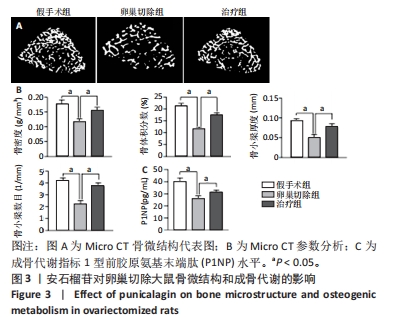
| [1] LEBOFF MS, GREENSPAN SL, INSOGNA KL, et al. The clinician’s guide to prevention and treatment of osteoporosis. Osteoporos Int. 2022;33(10):2049-2102. [2] MA ML, MA ZJ, HE YL, et al. Efficacy of vitamin K2 in the prevention and treatment of postmenopausal osteoporosis: A systematic review and meta-analysis of randomized controlled trials. Front Public Health. 2022;10:979649. [3] XU H, LIU T, HU L, et al. Effect of caffeine on ovariectomy-induced osteoporosis in rats. Biomed Pharmacother. 2019;112:108650. [4] WANG H, YANG L, CHAO J. Antiosteoporosis and bone protective effect of dieckol against glucocorticoid-induced osteoporosis in rats. Front Endocrinol. 2022;13:932488. [5] WU D, CLINE-SMITH A, SHASHKOVA E, et al. T-Cell Mediated Inflammation in Postmenopausal Osteoporosis. Front Immunol. 2021; 12:687551. [6] YANG K, QIU X, CAO L, et al. The role of melatonin in the development of postmenopausal osteoporosis. Front Pharmacol. 2022;13:975181. [7] WANG X, ZHANG X, HAN Y, et al. Role of the major histocompatibility complex class II protein presentation pathway in bone immunity imbalance in postmenopausal osteoporosis. Front Endocrinol. 2022; 13:876067. [8] LIM SY. Romosozumab for the treatment of osteoporosis in women: Efficacy, safety, and cardiovascular risk. Womens Health. 2022;18:17455057221125577. [9] ROZENBERG S, AL-DAGHRI N, AUBERTIN-LEHEUDRE M, et al. Is there a role for menopausal hormone therapy in the management of postmenopausal osteoporosis?. Osteoporos Int. 2020;31(12):2271-2286. [10] FISCHER V, HAFFNER-LUNTZER M. Interaction between bone and immune cells: Implications for postmenopausal osteoporosis. Semin Cell Dev Biol. 2022;123:14-21. [11] 麦合木提江•穆海麦提,买买提沙吾提阿吉•买买提,唐军伟,等.has-miR-100-5p靶向含7A的锌指和BTB结构域是绝经后骨质疏松的潜在靶标[J].中国组织工程研究,2023,27(32):5168-5172. [12] YUAN F, PENG W, YANG C, et al. Teriparatide versus bisphosphonates for treatment of postmenopausal osteoporosis: A meta-analysis. Int J Surg. 2019;66:1-11. [13] AIBAR-ALMAZÁN A, VOLTES-MARTÍNEZ A, CASTELLOTE-CABALLERO Y, et al. Current Status of the Diagnosis and Management of Osteoporosis. Int J Mol Sci. 2022;23(16):9465. [14] SILVA BC, MADEIRA M, D’ALVA CB, et al. Definition and management of very high fracture risk in women with postmenopausal osteoporosis: a position statement from the Brazilian Society of Endocrinology and Metabolism (SBEM) and the Brazilian Association of Bone Assessment and Metabolism (ABRASSO). Arch Endocrinol Metab. 2022;66(5):591-603. [15] 许萍,杨成武,黄淑芸,等.安石榴苷基于调整肠道菌群改善APP/PS1阿尔兹海默病小鼠认知功能的实验研究[J].中国临床药理学杂志,2022,38(18):2181-2186. [16] BERDOWSKA I, MATUSIEWICZ M, FECKA I. Punicalagin in Cancer Prevention-Via Signaling Pathways Targeting. Nutrients. 2021;13(8): 2733. [17] ALALAWI S, ALBALAWI F, RAMJI DP. The Role of Punicalagin and Its Metabolites in Atherosclerosis and Risk Factors Associated with the Disease. Int J Mol Sci. 2023;24(10):8476. [18] BHATNAGAR A, KEKATPURE AL. Postmenopausal Osteoporosis: A Literature Review. Cureus. 2022;14(9):e29367. [19] SUN D, PENG Y, GE S, et al. USP1 Inhibits NF-κB/NLRP3 Induced Pyroptosis through TRAF6 in Osteoblastic MC3T3-E1 Cells. J Musculoskelet Neuronal Interact. 2022;22(4):536-545. [20] ALI D, TENCEROVA M, FIGEAC F, et al. The pathophysiology of osteoporosis in obesity and type 2 diabetes in aging women and men: The mechanisms and roles of increased bone marrow adiposity. Front Endocrinol. 2022;13:981487. [21] YANG X, CHANG T, YUAN Q, et al. Changes in the composition of gut and vaginal microbiota in patients with postmenopausal osteoporosis. Front Immunol. 2022;13:930244. [22] ZHENG L, ZHUANG Z, LI Y, et al. Bone targeting antioxidative nano-iron oxide for treating postmenopausal osteoporosis. Bioact Mater. 2021;14:250-261. [23] JEONG HG, KIM MK, LIM HJ, et al. Up-to-Date Knowledge on Osteoporosis Treatment Selection in Postmenopausal Women. J Menopausal Med. 2022;28(3):85-91. [24] XU J, CAO K, LIU X, et al. Punicalagin Regulates Signaling Pathways in Inflammation-Associated Chronic Diseases. Antioxidants. 2021; 11(1):29. [25] LO J, LIU CC, LI YS, et al. Punicalagin Attenuates LPS-Induced Inflammation and ROS Production in Microglia by Inhibiting the MAPK/NF-κB Signaling Pathway and NLRP3 Inflammasome Activation. J Inflamm Res. 2022;15:5347-5359. [26] AL-KHAWALDE AAA, ABUKHALIL MH, JGHEF MM, et al. Punicalagin Protects against the Development of Methotrexate-Induced Hepatotoxicity in Mice via Activating Nrf2 Signaling and Decreasing Oxidative Stress, Inflammation, and Cell Death. Int J Mol Sci. 2022; 23(20):12334. [27] ZHANG Y, TAN X, CAO Y, et al. Punicalagin Protects against Diabetic Liver Injury by Upregulating Mitophagy and Antioxidant Enzyme Activities. Nutrients. 2022;14(14):2782. [28] ZHANG Z, JI C, WANG YN, et al. Maresin1 Suppresses High-Glucose-Induced Ferroptosis in Osteoblasts via NRF2 Activation in Type 2 Diabetic Osteoporosis. Cells. 2022;11(16):2560. [29] LONG Z, DOU P, CAI W, et al. MiR-181a-5p promotes osteogenesis by targeting BMP3. Aging (Albany NY). 2023;15(3):734-747. [30] OUYANG J, XIAO Y, REN Q, et al. 7-Ketocholesterol Induces Oxiapoptophagy and Inhibits Osteogenic Differentiation in MC3T3-E1 Cells. Cells. 2022;11(18):2882. [31] ZHOU M, GRAVES DT. Impact of the host response and osteoblast lineage cells on periodontal disease. Front Immunol. 2022;13:998244. [32] NAGASHIMA D, ISHIBASHI Y, KAWAGUCHI S, et al. Human Recombinant Lactoferrin Promotes Differentiation and Calcification on MC3T3-E1 Cells. Pharmaceutics. 2022;15(1):60. [33] TAN AQ, ZHENG YF. The Roles of SNHG Family in Osteoblast Differentiation. Genes . 2022;13(12):2268. [34] KAN T, HE Z, DU J, et al. Irisin promotes fracture healing by improving osteogenesis and angiogenesis. J Orthop Translat. 2022;37:37-45. [35] DARJANKI CM, PRAHASANTI C, FITRIA AE, et al. RUNX2 and ALP expression in osteoblast cells exposed by PMMA-HAp combination: An in vitro study. J Oral Biol Craniofac Res. 2023;13(2):277-282. [36] WANG MY, AN MF, FAN MS, et al. FAEE exerts a protective effect against osteoporosis by regulating the MAPK signalling pathway. Pharm Biol. 2022;60(1):467-478. [37] DAMANI JJ, DE SOUZA MJ, VANEVERY HL, et al. The Role of Prunes in Modulating Inflammatory Pathways to Improve Bone Health in Postmenopausal Women. Adv Nutr. 2022;13(5):1476-1492. [38] KERSCHAN-SCHINDL K, PAPAGEORGIOU M, FÖGER-SAMWALD U, et al. Assessment of Bone Microstructure by Micro CT in C57BL/6J Mice for Sex-Specific Differentiation. Int J Mol Sci. 2022;23(23):14585. [39] BROWN JP, ENGELKE K, KEAVENY TM, et al. Romosozumab improves lumbar spine bone mass and bone strength parameters relative to alendronate in postmenopausal women: results from the Active-Controlled Fracture Study in Postmenopausal Women With Osteoporosis at High Risk (ARCH) trial. J Bone Miner Res. 2021;36(11): 2139-2152. [40] WEE H, KHAJURIA DK, KAMAL F, et al. Assessment of Bone Fracture Healing Using Micro-Computed Tomography. J Vis Exp. 2022;(190): 10.3791/64262. [41] XIE H, HUA Z, GUO M, et al. Gut microbiota and metabonomics used to explore the mechanism of Qing’e Pills in alleviating osteoporosis. Pharm Biol. 2022;60(1):785-800. [42] KUNIOKA CT, MANSO MC, CARVALHO M. Association between Environmental Cadmium Exposure and Osteoporosis Risk in Postmenopausal Women: A Systematic Review and Meta-Analysis. Int J Environ Res Public Health. 2022;20(1):485. [43] LI Y, ZHANG R, REN M, et al. Experimental study on the effects of simvastatin in reversing the femoral metaphyseal defects induced by sodium valproate in normal and ovariectomized rats. Heliyon. 2022; 8(9):e10480. |
| [1] | Yang Yufang, Yang Zhishan, Duan Mianmian, Liu Yiheng, Tang Zhenglong, Wang Yu. Application and prospects of erythropoietin in bone tissue engineering [J]. Chinese Journal of Tissue Engineering Research, 2024, 28(9): 1443-1449. |
| [2] | Wang Wen, Zheng Pengpeng, Meng Haohao, Liu Hao, Yuan Changyong. Overexpression of Sema3A promotes osteogenic differentiation of dental pulp stem cells and MC3T3-E1 [J]. Chinese Journal of Tissue Engineering Research, 2024, 28(7): 993-999. |
| [3] | Wei Yuanxun, Chen Feng, Lin Zonghan, Zhang Chi, Pan Chengzhen, Wei Zongbo. The mechanism of Notch signaling pathway in osteoporosis and its prevention and treatment with traditional Chinese medicine [J]. Chinese Journal of Tissue Engineering Research, 2024, 28(4): 587-593. |
| [4] | Zhu Zhiqi, Yuan Sijie, Zhang Zilin, Ji Shijie, Meng Mingsong, Yan Anming, Han Jing. Mechanism underlying the effect of Liuwei Dihuang Pill on osteolysis and osteogenesis induced by titanium particles [J]. Chinese Journal of Tissue Engineering Research, 2024, 28(3): 392-397. |
| [5] | Li Shudong, Liang Xuezhen, Luo Di, Li Jiacheng, Yan Bozhao, Li Gang. Identification of biomarkers associated with ferroptosis and pyroptosis for the potential diagnosis of postmenopausal osteoporosis [J]. Chinese Journal of Tissue Engineering Research, 2024, 28(28): 4511-4515. |
| [6] | Chen Xiangshan, Liu Hua, Sun Weikang, Li Huanan. Mechanism of m6A methylation regulating bone metabolism for prevention and treatment of osteoporosis [J]. Chinese Journal of Tissue Engineering Research, 2024, 28(28): 4572-4577. |
| [7] | Yang Qipei, Chen Feng, Cui Wei, Zhang Chi, Wu Ruiqi, Song Zhenheng, Meng Xin. Signaling pathways related to kaempferol active monomers in the treatment of osteoporosis [J]. Chinese Journal of Tissue Engineering Research, 2024, 28(26): 4242-4249. |
| [8] | Li Jiale, Luo Dasheng, Zheng Liujie, Liu Wei, Yao Yunfeng. Human osteoarthritic chondrocytes up-regulate the expression of osteoprotegerin in osteoblasts via the Indian hedgehog signaling pathway [J]. Chinese Journal of Tissue Engineering Research, 2024, 28(26): 4194-4201. |
| [9] | Yang Shanshan, Ouyang Renjun, Tian Jia, Linghu Min, Wang Zhen, Yang Xiaohong. Detection of immune-related cytokines of bone marrow mesenchymal stem cells in postmenopausal osteoporosis mice by antibody chip and analysis of key differential genes [J]. Chinese Journal of Tissue Engineering Research, 2024, 28(25): 3947-3954. |
| [10] | Yu Yangyi, Lian Qiang, Wu Jianqun, Zhang Xuan, Ren Jinke, Li Guangheng. Cell-of-origin for heterotopic ossification induced by bone morphogenetic protein 4 in skeletal muscle [J]. Chinese Journal of Tissue Engineering Research, 2024, 28(25): 4034-4040. |
| [11] | Luo Peng, Wang Yi, Wang Ansu, Dang Yi, Ma Yaping, Zhang Yi, Wang Xin. Role and mechanism of interleukin-8 in bone regeneration [J]. Chinese Journal of Tissue Engineering Research, 2024, 28(24): 3910-3914. |
| [12] | Xie Ting, Liu Tingting, Zeng Xuehui, Li Yamin, Zhou Panghu, Yi Nianhua. Fucoxanthin alleviates glucocorticoid-induced osteoblast apoptosis by activating nuclear factor erythroid-2-related factor 2 [J]. Chinese Journal of Tissue Engineering Research, 2024, 28(23): 3609-3614. |
| [13] | Han Jie, Peng Qinglin, Xu Zhiwei, Wu Yukun, Ren Guowu, Xie Xiaozhong, Jin Wanqing, Yang Ling. Active ingredients of Panax notoginseng regulate signaling pathways related to steroid-induced necrosis of the femoral head [J]. Chinese Journal of Tissue Engineering Research, 2024, 28(23): 3751-3758. |
| [14] | Wang Xin, Wubulikasimu·Mijiti, Huang Jinyong, Xie Zengru. Regulation of bone tissue cells by tumor necrosis factor-alpha [J]. Chinese Journal of Tissue Engineering Research, 2024, 28(21): 3400-3406. |
| [15] | Xiong Wanqi, Li Zhenhao, Cui Yan, Liu Jiahe, Li Chenzhi, Wu Mingjian, Li Yancheng, Yang Fan, Liu Baoyi. Effects of biomechanics on biological characteristics of osteoblasts [J]. Chinese Journal of Tissue Engineering Research, 2024, 28(21): 3407-3412. |
| Viewed | ||||||
|
Full text |
|
|||||
|
Abstract |
|
|||||
